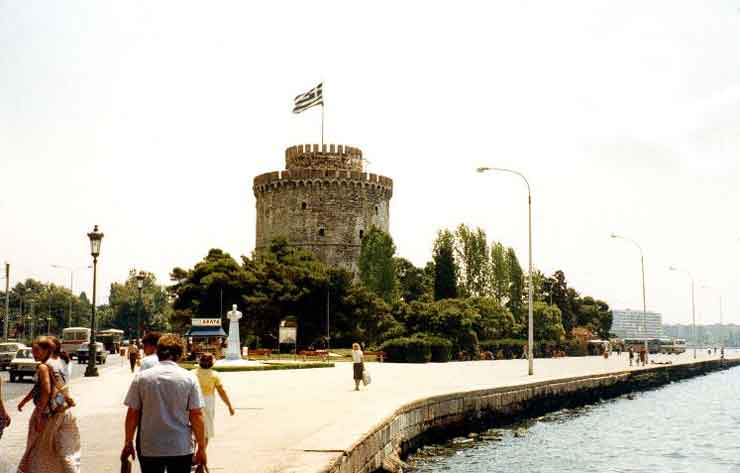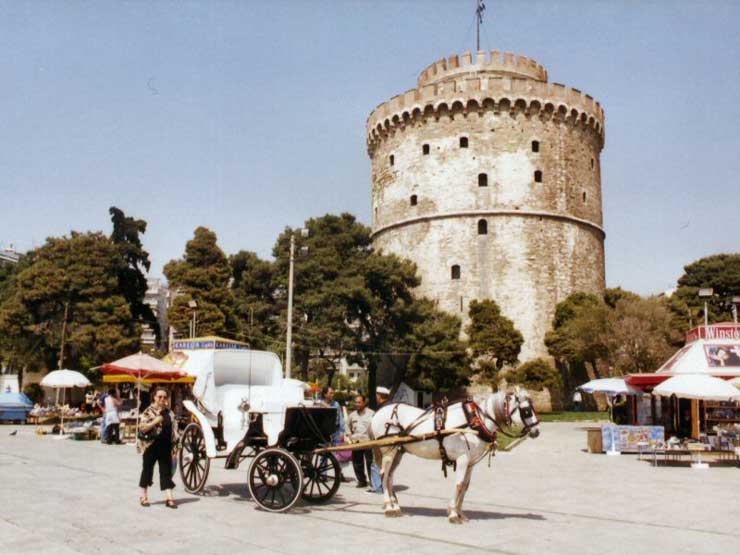.

White Tower in Thessaloniki, , Image : Alexander Buschorn (1981) (One image artifact removed)
The White Tower of Thessaloniki (in Greek, Λευκός Πύργος, Lefkos Pyrgos, in Macedonian: Бела Кула, Bela Kula, Turkish Beyaz Kule) is a monument and museum on the waterfront of the city of Thessaloniki, capital of the region of Macedonia in northern Greece. It has been adopted as the symbol of the city, and also as a symbol of Greek sovereignty over Macedonia.

The White Tower in the first half of the 19th century
The present tower dates from the reign of the Ottoman Sultan Suleiman the Magnificent (1520-66). There was an older tower on the same site, probably built by French knights during the period of the Latin Empire in Constantinople. The Tower was used by the Ottomans successively as a fort, garrison and a prison. In 1826, at the order of the Sultan Mahmud II, there was a massacre of the prisoners in the Tower. Owing to the "countless victims of Ottoman torturers and executioners", the tower acquired the name "Tower of Blood", which it kept until the end of the eighteenth century[1].
The Tower was for centuries part of the walls of the old city of Thessaloniki (known as Salonik in Ottoman times), and separated the Jewish quarter of the city from the cemetaries of the Muslims and Jews[2]. The city walls were demolished in 1866. When Thessaloniki was captured by the Greeks during the Balkan War of 1912, the tower was whitewashed as a symbolic gesture of cleansing, and acquired its present name. King George I of Greece was assassinated not far from the White Tower in March 1913.
The Tower is now a buff colour but has retained the name White Tower. It now stands on Thessaloniki's waterfront boulevard, Nikis (Victory) Street. It houses a Byzantine museum and is one of the city's leading tourist attractions. The Tower is under the administation of the Ephorate of Byzantine Antiquities of the Greek Ministry of Culture.
After the independence of the FYROM (Former Yugoslav Republic of Macedonia) in 1991, the White Tower became a symbol of the dispute between Greece and FYROM over the name "Macedonia" and the symbols of Macedonian history (see also Vergina sun). According to the New York Times, a version of the new country's currency began to appear in January of 1992[1]. The bills circulating contained an image of Thessaloniki, depicting the White Tower. The bills prompted "outrage in Athens and... in the capital of Greek Macedonia [Thessaloniki]"[3]. The bills were never used by the government of the Republic of Macedonia.

Description: 1992 currency printed after the FYROM declared independence from Yugoslavia in 1991. The bill shows the White Tower of Thessaloniki, an architectural landmark of the Greek city. The bills were never officially used.Source: http://www.greece.org/themis/macedonia/article3.htm (an article by Bill Gatzoulis and Marcus Templar at Greece.org)
FYROM nationalist groups have advanced territorial claims over what they call "Aegean Macedonia," and these groups have used the White Tower as a symbol of their claims that Thessaloniki (which they call Solun) ought to be part of a greater Republic of Macedonia. Since the 1995 agreement between Greece and FYROM, however, it does not appear that the government of FYROM has given these groups official encouragement.

Thessaloniki, White Tower, 2002 (Source)
References
Glenny, Misha (2001). “A maze of conspiracy”, The Balkans: Nationalism, War and the Great Powers, 1804-1999, Penguin 2001 softcover, 181, New York, New York: Penguin. ISBN 0140237776.
Simons, Marlise, "As Republic Flexes, Greeks Tense Up", New York Times, February 3, 1992.
Notes
^ Glenny, p.181
^ Glenny, p.181
^ Simons
| Ancient Greece
Science, Technology , Medicine , Warfare, , Biographies , Life , Cities/Places/Maps , Arts , Literature , Philosophy ,Olympics, Mythology , History , Images Medieval Greece / Byzantine Empire Science, Technology, Arts, , Warfare , Literature, Biographies, Icons, History Modern Greece Cities, Islands, Regions, Fauna/Flora ,Biographies , History , Warfare, Science/Technology, Literature, Music , Arts , Film/Actors , Sport , Fashion --- |


